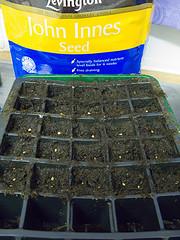
Early seed plantings (Photo credit: Tony Austin)
I like to listen to garden podcasts while I’m working in the garden (and, oddly, when I’m at the gym), and one of my favorites is Gardeners’ Question Time, from the BBC. Although it can be challenging to filter the discussions through the lens of my own, very different growing conditions, the program offers insights from extremely skilled and knowledgeable horticulturalists. I learn something new and interesting every time I listen.
One theme regularly recurs on the podcasts: recommendations of John Innes compost. Compost, in this context, refers to what American gardeners typically call potting soil. This compost is referred to with reverence by the gardening audience and the expert panelists alike, and seems to my foreign ears to be an underlying assumption of competent gardening in the UK. All your seedlings died? Well, did you use John Innes compost (you fool)? The question, in fact, precedes queries regarding basic care: “Did you water them? Did you expose the plants to light?”
This fascinates me. It appears from my research to be basic potting medium with set proportions of nutrients. But this cannot be the whole story. Clearly there must be something extraordinary about this compost, which doesn’t have an equivalent Stateside. There is no potting soil product in the US that inspires equal adoration. And to my knowledge, John Innes products are not available for sale in the US. I cannot discover the magic firsthand.
I admire UK gardeners’ devotion to organic methods and I wonder how John Innes relates to this. I know there are a few UK gardeners who read my blog. Please, demystify this issue for me! What is so magical about John Innes compost?

